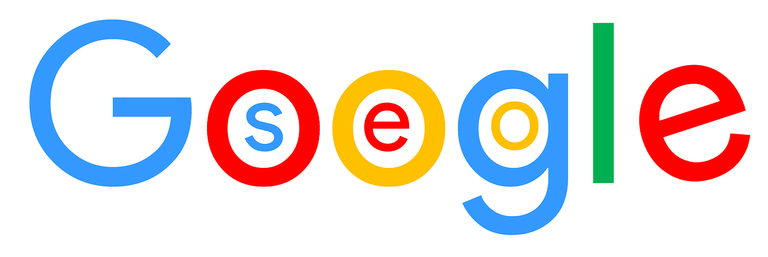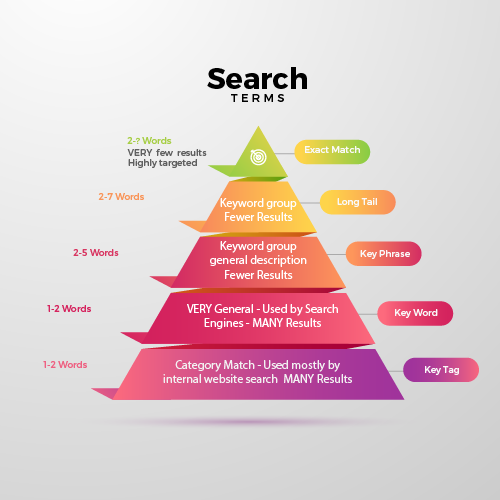Key words, key terms, key phrases are the heart and soul of Search Engine Optimization. Not since the days of Merlin has more myth, magic and mystery surrounded something than that which surrounds keywords.

Let’s start by digging into HOW our visitor conducts a search. When search engines first started many moons ago, one word search terms, often separated from another search term by a comma, was the way search happened. The engines looked at each word and then matched the website that used those words most often in their content. Those were the top site address that were returned to the searcher.
As engines got better at their job, and people became more familiar with how to search, those words were no longer one word separated from another word with a comma. Now you could enter entire phrases and the little bots would find those phrases in website content and give you the best results that used those phrases.
In today’s world of search you can enter a question or an entire sentence and get the results you’re looking for. In today’s world, the bots look at what is on the page, what is linked to the page, where those links come from, and many other criteria to determine the top sites for your query. These sites can, and often do, include store fronts, videos, images, news reports and more in addition to the “normal” website.
The engines ignore common words like “the”, “and”, “of”, etc. and only look at the “main keyterms” you have entered in your search. As a site owner, if you have the words entered in the search, but in a different order, or if you’ve left out one or two of them, you will STILL come up in the results. Yes the search algorithms have certainly progressed since the early days!
To understand the world of keyterms we need to understand what some of the terms used by the SEO wizards actually mean.

Keyterm - USUALLY means one word that is being searched like “dog”. In today’s world, any keyterm, or group of keyterms that form a phrase are referred to as “keyterm”
Key tags - a short, often one word keyterm, sometimes a category name used only by onsite searches such as Steemit to filter and present content by category. MOST modern websites allow a far more robust search by phrases in an onsite search box, but will still have a number of “tag” entries for the content provider to fill in. While major search engines do pay some attention to these “tags” they are mostly used for onsite searches and we’ll go into that type of search and how it works with major engines in a later segment.
Keyphrase - a group of keywords that go together such as “dog house” or “dog food”
Long tail keyterm - a longer keyphrase such as “gluten free dog food”
Exact match - a key phrase that exactly matches the entered search words in the same order as the entry. Example - if you have a dog food description that contains the keyphrase “grain-free, gluten free dog food” it is an exact match for “Show me the best grain-free, gluten free dog foods” entered as a search query.
In the example above, the search engine will ignore “show me the” Google almost always ignores the word “best” and it also doesn’t care about plurals so it will see “food” and “foods” as the same word.
NOTE: Sometimes it WILL see “grain-free” and “grain free” (without the hyphen) as two different keyterms.
When you research your keyterms - be SURE to check and see if a hyphenated version of a word is searched for more frequently than the unhyphenated version. BUT include BOTH in your content.
If your research shows that the hyphenated version has many more searches for it than the unhyphenated version, use the hyphenated twice as often as the unhyphenated version of the term. That way, you’ll be closer to an exact match from both sets of visitors. (More on keyword research will come in a later segment)
The best practice for SEO is to use 2-5 word phrases rather than a bare single word when possible because you will get the perfect customer who is ready to buy or consume your content if you are closer to what they are exactly searching for.

Let’s look at how the visitor conducts a search. Visitors rarely purchase from the first site they hit in a search, or consume much of the content on the page of that initial search. Using our dog food as an example, they will probably enter something like “dog food” in their first search. A zillion pages will be returned and they will modify that search, often without visiting ANY of the sites that show on the first SERP.
The next search will be modified a bit and may look something like “canned dog food” which will return a different list of sites. They may hit a couple of those, and then modify even further to something like “grain free canned dog food”. Now they have even fewer choices and begin to truly dig into those sites that come up. A final search - I call it the Ready To Take Action search - will probably be something like “free shipping on canned grain free dog food”.
IF you have that exact phrase on your page, it will probably be returned as a search result very high on the list. But even if you don’t have that exact phrase, that “exact match” you will still come up if you have the terms “free shipping” “canned dog food” “grain free dog food” or any combination of those terms, in close proximity to each other.
Once you think about HOW your perfect visitor is looking for you, you can deliver your content with the words THEY are using to conduct that search.
NEVER EVER WRITE FOR THE BOTS
Write for people! Bots don’t have wallets, and they never take action - only people do.
 Courtesy of Pixabay
Courtesy of Pixabay
Stop thinking about search from a bot standpoint, start your process thinking about HOW a perfect visitor will find your content. The Prime Directive of any search engine s to return the best results that have the content the visitor is looking for based on the search query they have entered into the search box. The bots look at far more than just your search terms to fulfill that Prime Directive. So don’t waste your time attempting to write “bot-friendly” text - it doesn’t work. Satisfy your perfect visitor and you will have satisfied the bots.
In our next session we’ll dive into how to find the tricksey little search terms YOUR perfect visitors are using.
SEO is currently complex. When doing SEO, you need to have a proper plan, especially when it comes to technology companies. If you are looking for information on this etmat, I recommend this post: https://www.deviantart.com/brunox99/art/How-to-Do-SEO-for-Technology-Companies-Step-by-St-966933639